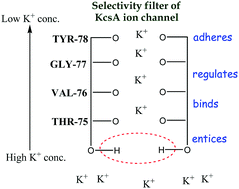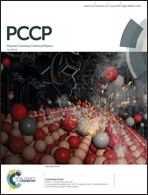Roles of different amino-acid residues towards binding and selective transport of K+ through KcsA K+-ion channel†
Abstract
The roles of different amino acid residues towards binding and selective transport of K+ ion in the selectivity filter of the bacterial K+ ion channel, KcsA, were explored. The selectivity filter of KcsA contains amino acids threonine (THR-75), valine (VAL-76), glycine (GLY-77) and tyrosine (TYR-78) from intracellular to extracellular regions. The hydroxyl-hydrogen and carbonyl-oxygen of THR-75 situated at the intracellular region are engaged in intra-residue hydrogen bonding. Thus, the hydroxyl-oxygens orient away from and the hydroxyl-hydrogens orient towards the center of the selectivity filter. Hence, this site attracts and acts as a ‘gate’ for the incoming K+ ion. The binding of K+ ion is first observed with eight carbonyl-oxygens of THR-75 and VAL-76 (S3 site). However, binding at this site breaks the intra-residue hydrogen bonding of THR-75, which in turn reorients the hydroxyl-hydrogens away from the selectivity filter. Accordingly, binding of K+ ion at this site prevents the instantaneous approach of another K+ ion. Thus, VAL-76 acts as a ‘hinge’ to open and close the ‘gate’. The next amino acid, GLY-77, shows low affinity towards K+ ion, thus acting as a ‘regulator’. TYR-78 situated at the extracellular region shows strong binding affinity towards K+ ion, and thus assists in the transport of K+ ion from the intracellular to the extracellular region. The release of K+ ion to form hydrated K(H2O)8+ in the extracellular region is endothermic (4.9 kcal mol−1). Hence, the process of K+ ion transport is likely to be kinetically controlled. Moreover, the highest binding energy of Na+ is observed at the center of four carbonyl-oxygens of VAL-76 (−68.8 kcal mol−1), which is even higher than the highest binding energy of K+ ion at S3 (−63.9 kcal mol−1). Na+ binding energy decreases from intracellular to extracellular region. Hence, intracellular Na+ ion would block the passage of K+ ion. The K+ ion concentration is high in the intracellular region, and it moves from intracellular to extracellular region, while Na+ ion concentration is high in the extracellular region, and it moves from extracellular to intracellular region. Thus, the selective transport of K+/Na+ ion in KcsA can be attributed to the competition between K+ ion exit and Na+ ion entry at the center of four carbonyl-oxygens of TYR-78.



 Please wait while we load your content...
Please wait while we load your content...